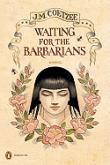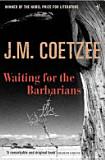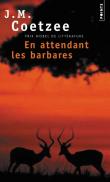AustLit
Latest Issues
AbstractHistoryArchive Description
After twenty years of peacefully running one of the Empire’s settlements, a magistrate takes pity on an enemy barbarian who has been tortured. He enters into an awkward intimate relationship with her, and then is himself imprisoned as an enemy of the state.
Waiting for the Barbarians is a disturbing political fable about oppression, the fraught desire for reparation, and about living with a troubled conscience under an unjust regime.'
Source: Publisher's blurb.
Adaptations
-
Waiting for the Barbarians
2014
single work
screenplay
— Appears in: Two Screenplays 2014;
Notes
-
Dedication:
For
Nicolas and Gisela
-
Editions and translations have been updated for Waiting for the Barbarians by Eilish Copelin as part of a Semester 2, 2013 scholar's internship.
Given the international popularity of Coetzee's work, however, this record is not yet comprehensive. Due to the enormous breadth of critical material on Coetzee's work, indexing of secondary sources is also not complete.
Publication Details of Only Known VersionEarliest 2 Known Versions of
Other Formats
- Braille.
- Sound recording.
Works about this Work
-
《等待野蛮人》:一部人类纪环境警示录)
2019
single work
criticism
— Appears in: Contemporary Foreign Literature , vol. [2019] no. 4 2019; (p. 119-126) In approaching J. M. Coetzee’s Waiting for the Barbarians, critics have tended to focus on torture and its rich political and ethical connotations, with insufficient attention paid to its environmental concerns. In fact, in the novel, Coetzee not only describes the harsh environment and climate, but also explores the conflicts between human beings and the environment through the imperial army’s strange defeat in the war against its imaginary "barbarian" enemy. Waiting for the Barbarians is therefore an environmental warning for the Anthropocene. One feasible way out of this predicament is the Confucian ecological philosophy, which aims at realizing the harmony between man and nature, emphasizes the solidarity between them, and advocates that human beings, as subjects of virtue, should consciously improve their moral cultivation, respect nature and treat all forms of life with benevolence. (Source: publisher's abstract). -
'A New Footing' : Re-reading the Barbarian Girl in Coetzee’s Waiting for the Barbarians
2019
single work
criticism
— Appears in: Reading Coetzee's Women 2019; (p. 55-68) -
Type, Personalisation and Depersonalisation in J.M. Coetzee's 'Waiting for the Barbarians'
2018
single work
criticism
— Appears in: Commonwealth Essays and Studies , Spring vol. 40 no. 2 2018; (p. 23-32)''Waiting for the Barbarians' (1980) recounts the rebellion of the Magistrate of an Empire frontier outpost against the torture inflicted on those the Imperial administration which employs him considers as "barbarians." The first-person narration is a strategy enabling the author to personalize the Magistrate whose name he never reveals, above all because through it we are allowed to witness the workings of conscience. The novel is a drama of the opposition between justice and law, and of what happens when men who are supposed to uphold the law in fact neglect justice and abuse their power, themselves becoming worse than "barbarians." Within this complex moral and ethical framework the essay at hand proposes to explore the modalities of personhood as established by Coetzee, and its limits.' (Publication abstract)
-
The Communion of Clouds : Becoming-Woman in Coetzee’s Waiting for the Barbarians
2018
single work
criticism
— Appears in: Australian Literary Studies , February vol. 33 no. 1 2018;'In her well-read work on contemporary feminist theory titled Nomadic Subjects (2011), Rosi Braidotti gets to grips with the Deleuzian notion of ‘becoming-woman’. Noting that the concept has experienced a good deal of criticism in feminist circles (and from some important feminists too, such as Luce Irigaray), Braidotti argues that there is still something of extreme importance in this concept for the feminist to recover. For Braidotti, ‘becoming-woman’ allows for ‘a nonunitary and multi-layered vision’ of the subject. That is to say, it allows for the description of ‘a dynamic and changing entity’ (5) – one that challenges the striated formulations of ‘woman’ found in phallo- and Euro-centric master codes. Importantly, however, it does so not by posing an essentialised subject position of ‘woman’ for others either to mimic or aspire to (often the grounds for the misreading of the concept), but rather by referencing ‘woman’ as an intensity of sorts, an intensity that is the pre-condition for both revolutionary thought and action (249-250).
'This paper takes the Deleuzian concept of ‘becoming-woman’ and uses it as a way to understand the enigmatic relationship that develops between the Magistrate and the barbarian girl in Coetzee’s early novel, Waiting for the Barbarians (1980). Beginning with a brief characterisation of the barbarian girl as an agent of transformation, this paper goes on to offer an explanation for why the encounter between the Magistrate and the barbarian girl necessarily results in the Magistrate’s turn away from the State.' (Publication abstract)
-
Raising Introspective Awareness in Resisting Colonizing Ideologies : Coetzee's Waiting for the Barbarians
2017
single work
criticism
— Appears in: Advances in Language and Literary Studies , vol. 8 no. 5 2017; (p. 103-107)'Deconstructing colonization and the colonizing discourse is a long and continuing process. Many intellectuals participated, and still participate, in this noble mission. However, "Waiting for the Barbarians" is a literary work that resists the colonial ideology through raising the colonizer's, and consequently the reader's, awareness of the pervasive ideology of dehumanization; it is this ideology that makes possible the severe torture of the prisoners without the torturers' feeling or awareness of their criminal deeds. This ideology of dehumanization and the struggle against its domination is manifested by the character of the protagonist who, as a representative of the colonizer, experiences a gradual process of confusion, introspection, and remorse that enables the reader to experience closely, rather than merely witness from a distance, an exemplary process of self-questioning. This theme of self-questioning is one of the main themes of Coetzee's Waiting for the Barbarians. The novel creates in us an ability to question the different ideologies that enslaved us unconsciously, especially at our modern time when It seems that we became so obsessed with materialism and our existential needs that risking one's physical safety or financial security to stand up for one's principles will never be an issue for most people, especially those living in what was known as colonizing countries or, in modern terminology, the developed or first world. Thus, the aim of this paper is to investigate how the novel creates in its reader a revival of a moral and ultimately political sensibility that is usually inhibited by the ideology of dehumanization.' (Publication abstract)
-
Hunting Animals in JM Coetzee's Dusklands and Waiting for the Barbarians
2013
single work
criticism
— Appears in: Social Alternatives , vol. 32 no. 4 2013; (p. 15-20)‘J.M. Coetzee’s early novels Dusklands (1974) and Waiting for the Barbarians (1980) outline the Western imperialist project to colonise and subjugate ‘other’ people, animals and the environment. The masculine colonising subject (in Cartesian terms, res inextensa) has separated itself from the world (res extensa) and seeks to conquer and subjugate in order to subsume it. Dusklands comprises two narratives: one, that of Jacobus Coetzee who hunts human and nonhuman animals and leaves a destructive trail behind him as he blazes a frontier in 1800s South Africa; and two, Eugene Dawn, an American mythographer, who advocates his ‘Vietnam Project’ to win the US war in Vietnam in the early 1970s by defoliating the environment and hunting the Vietcong ‘like animals’. In Waiting for the Barbarians, Colonel Joll deals with the Barbarian ‘threat’ to his Empire by similarly destroying the environment, hunting barbarians, and torturing woman and children. Each character is locked into a Cartesian ‘self’ consciousness that cannot interact with the ‘other’ (female, nonhuman animal, ‘indigenous’) except through violence and destruction. Hunting is a manifestation of this disease and the protagonists make no distinction between human, animal or vegetable in their path of destruction in the name of colonial expansion.' (Publication abstract)
-
The Gate Deferred : J.M. Coetzee and the Battle Against Doubt
2013
single work
criticism
— Appears in: Southerly , vol. 73 no. 3 2013; (p. 90-111) 'Esposito writes of Coetzee's characters (it is not Elizabeth Costello alone) in effect morally naked at the Gate, awaiting admission after - or so they think - the passing of a last judgement, but what is it that is expected of them, and what is this a gate to? (David Brooks, 'Editorial' p. 6) -
Teaching Coetzee’s Subject : Waiting for the Barbarians and Disgrace
2014
single work
criticism
— Appears in: Approaches to Teaching Coetzee's Disgrace and Other Works 2014; (p. 59-66) -
Open to Interpretation : Politics and Allegory in Coetzee’s Waiting for the Barbarians
2014
single work
criticism
— Appears in: Approaches to Teaching Coetzee's Disgrace and Other Works 2014; (p. 146-151) -
Sven Hedin's “Vanished Country” : Setting and History in J.M. Coetzee's Waiting for the Barbarians,
2015
single work
criticism
— Appears in: Scrutiny2 , vol. 20 no. 1 2015; (p. 103-127) 'Since J.M. Coetzee’s manuscripts, notebooks and miscellaneous other archival materials have become available for study at the Harry Ransom Centre (HRC) in Texas in 2013, it has become possible to shed new light on one of the more enigmatic aspects of Coetzee’s early fictions, namely the origins of the setting and landscape of Waiting for the barbarians. With his previous two novels, Dusklands (1974) and In the heart of the country (1977), Coetzee had established himself as a significant avant-garde South African writer, but the next novel, Barbarians (1980), on the face of it, seemed to veer off-course as an engagement with the historical trauma of his country. When the book was published, readers and critics found Coetzee’s choice of a richly detailed yet seemingly invented non-South African setting both attractive and puzzling. Irvin Howe wrote in the New York times that the novel’s landscape was an “unspecified place and time, yet recognizable as a ‘universalised’ version of South Africa”, and Bernard Levin, in an influential London Sunday times review, thought that the story appeared to indict the repressive South African political situation, “[b] ut that beneath the surface it is timeless, spaceless, nameless and universal” (1980: n.p.). A reviewer in Newsweek thought that Coetzee’s “terrain is African” but that “subtle dislocations in time and geography, however, make it clear that his political parable is set in a mythical realm” (Clemons 1980: 55). Peter Lewis (1980: 1270) also recognized allusions to South Africa, but concluded that “the place cannot be located on any map”. In many critical responses there was a tension between a desire to read the novel as a South African narrative, and a simultaneous recognition of the story’s non-specific emplacement which transcended the political oppression of late apartheid. It was precisely the text’s sense of geographical and historical dislocatedness that made it a compelling reading experience, as for example articulated by Peter Wilhelm: “The strange landscapes, part-African, part a country of the mind; the sense of action and thought scarcely disturbing the flux of time; the crystalline lucidity of the language – these will haunt the reader long after the novel has been set aside” (cited in Kannemeyer 2012: 345). ' (Author's introduction)
Awards
- 1981 winner Geoffrey Faber Memorial Prize
- 1980 winner Central News Agency Literary Award (CNA Literary Award)
- 1980 winner James Tait Black Memorial Prize
-
cSouth Africa,cSouthern Africa, Africa,















